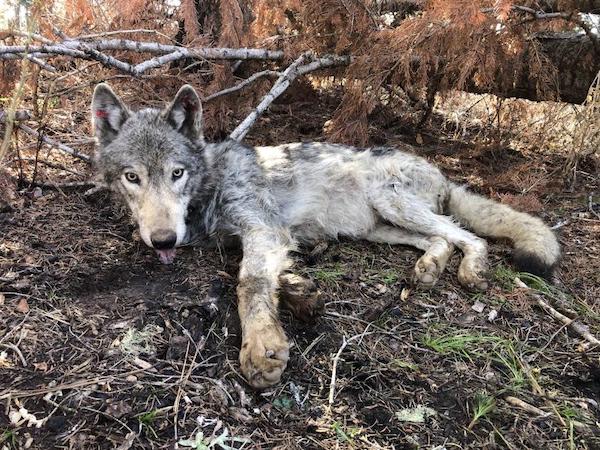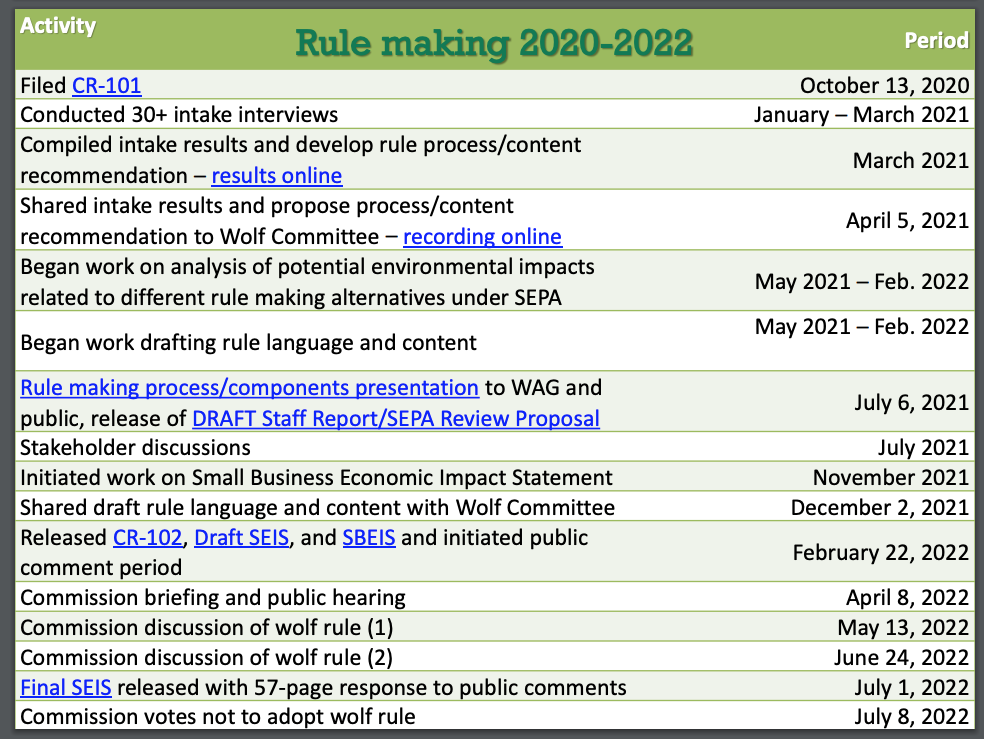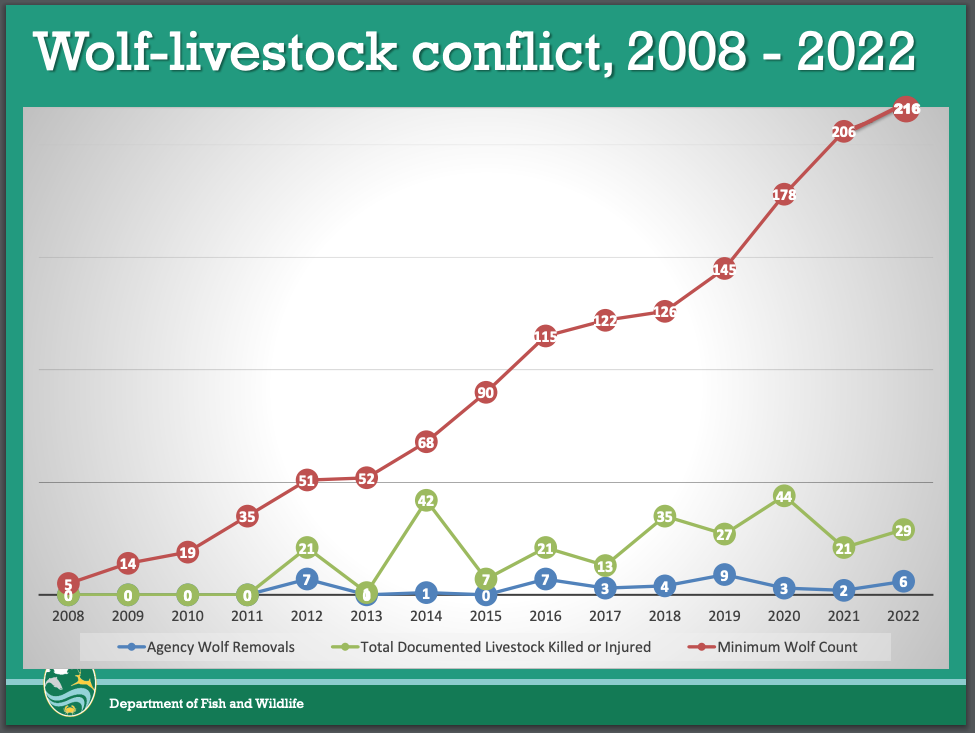
Groups Again Appeal To Inslee Over Commission Wolf-Livestock Decision
Pro-wolf groups are yet again appealing to Washington Governor Jay Inslee to order WDFW to begin rulemaking around “enforceable” wolf-livestock conflict management standards after the state Fish and Wildlife Commission declined to do so in late October.

The nearly one dozen organizations claim the commission overseeing WDFW was “forced into a hasty vote” last month and asked the governor to reverse that denial in a November 27 letter.
It’s the second time the out-of-state Center for Biological Diversity, Cascadia Wildlands, Western Watersheds Project and WildEarth Guardians have tried to go through Inslee to institute more tightly shackling rules around conditions that must be met before lethal removals can be done to head off chronic wolf depredations, and in this latest attempt they are joined by Washington Wildlife First, Center for a Humane Economy, Northwest Animal Rights Network, Kettle Range Conservation Group, Predator Defense, Endangered Species Coalition, and Coexisting with Cougars in Klickitat County.
The governor agreed with the general idea in September 2020 and ordered WDFW to begin rulemaking, but after a long internal process the commission ultimately demurred in a very testy 5-4 May 2022 vote, with Chair Barbara Baker stating that approving the new rules would “chill the advancements we are making.”

This past summer the groups again petitioned the Fish and Wildlife Commission to begin rulemaking to amend WAC 220-440-080, temporarily withdrew their request, refiled it and then saw it fail by a wider margin, with Baker, Vice Chair Molly Linville and Commissioners Jim Anderson, John Lehmkuhl, Steven Parker and Woody Myers in favor of denying it and Commissioners Tim Ragen, Melanie Rowland and Lorna Smith voting the other way.
It hasn’t sat well with the 11 organizations and now they’re bringing it to the attention of the state’s chief executive to try and get their way.
“Petitioners brought this rulemaking petition in the hopes it would facilitate the serious discussion the Commission should have had three years ago about how to reduce wolf mortality and facilitate wolf recovery. Unfortunately … Commission leadership only allocated an hour on the Commission agenda to consider the petition – refusing to give petitioners a chance to be heard, hold committee meetings to explore the issues raised, or allow commissioners to hear from leading national experts on wolf-livestock conflict deterrence,” they state in their letter to Inslee.
They claim the commission received “false and misleading information from WDFW,” though they don’t mention the false and misleading information in their own petition – 10 assertions that “taxpayer dollars,” “taxpayer funds” or “taxpayer money” is used to kill problem wolves when in fact hunting and fishing license revenues are used for that last-resort action.
The groups want “enforceable” standards, which CBD’s Amaroq Weiss describes in a supporting letter also sent to Inslee as “requirements that must be met before the state will consider killing wolves.”
Those include requiring that all wolf depredations inside a 30-day window be confirmed (currently, one of three incidents can be probable) and have resulted in the deaths of at least two head before lethal action occurs, as well as require ranchers to have used a minimum of two proactive deterrents; define exactly what range riding means; bar wolf removals on public land; limit kill orders to 30 days and only affect one wolf out of a pack; prevent removals near core wolf use areas and not if pups might be impacted; and require ranchers to have signed damage control prevention agreements before any wolves are killed on their behalf.
WDFW, in recommending the commission deny this year’s petition, argued against codifying wolf management rules because it felt conflict prevention is better handled by local staff building personal relationships with livestock operators, continuing with the years-long collaborative process seen with the Wolf Advisory Group and the hard-won agreed-to protocol, and expanding proactive nonlethal deterrences and figuring out new programs along those lines.
In a Capital Press article, Weiss states that without the rules in place to make lethal removal a last resort, the groups “expect things will get worse” and in their appeal, they claim that since the first time Inslee directed WDFW to start rulemaking around wolf-livestock conflicts, the agency “has continued to kill wolves unabated.” In the Press‘s piece, agency wolf policy manager disputed the idea that WDFW is killing more wolves, stating, “It’s false. It’s simply not true.”
Since 2012, WDFW has lethally removed 44 wolves, a tally that includes permits issued to ranchers, for an average of 3.6666666667 wolves a year. More than half of those occurred in just three problematic years, 2012, 2016 and 2019, but while there’s been something of an every-fourth-year flareup around depredations and/or removals, 2023 will go down as “one of the lightest conflict years in recent years,” according to a Spokane Spokesman-Review article out today.
Another nine wolves have been shot by livestock operators and others after the predators were observed chasing or killing cattle or domestic animals, the so-called caught-in-the-act provision allowed by the commission at the request of state lawmakers from both parties in 2013.
The pro-wolf groups also try to flatter Inslee with the notion Washington has a chance to “become a national leader in the rational, science-based management of wolves, while paving the way for a successful statewide wolf recovery effort.”
Washington is already a leader in both regards under Inslee. A 2022 review by more pragmatic and involved wolf advocates found that from 2017 through 2021 the state’s wolves had the lowest rate of human-caused mortality out of the five Northwest states where the species is either fully or partially federally delisted and termed the state “the best place to live if you are a wolf in the western United States.”
According to WDFW, the state’s wolf population has seen 14 straight years of growth, increasing an average of 23 percent every year since the first pack was confirmed in 2008, and two of WDFW’s three recovery zones have reached – well exceeded in one case – successful breeding pair goals and there’s a breeding pair in the third zone, all despite state lethal removals for livestock depredations, as well as caught-in-the-act removals, legal tribal hunting and illegal poaching. Earlier this year, WDFW proposed downlisting the species from state endangered to protected-sensitive status.

Weiss’s letter also claims the commission’s wolf petition vote in late October occurred “in an atmosphere of fear and intimidation” among “hunters in camouflage and wearing animal skins,” with some allegedly engaging in “heckling and harassment of attendees, especially women, in the overflow room.”
However, Brian Blake, the former state legislator from Aberdeen who hunts waterfowl, deer and elk, refuted that, saying, “I was in that room frequently and this characterization is factually untrue.”
Most hunters were in attendance to speak about the meaning of the hunting to them and their families and to voice concern about the commission’s draft Conservation Policy.
The Spokesman-Review also reported at the Governor’s Office has 45 days to respond to the groups’ appeal.
